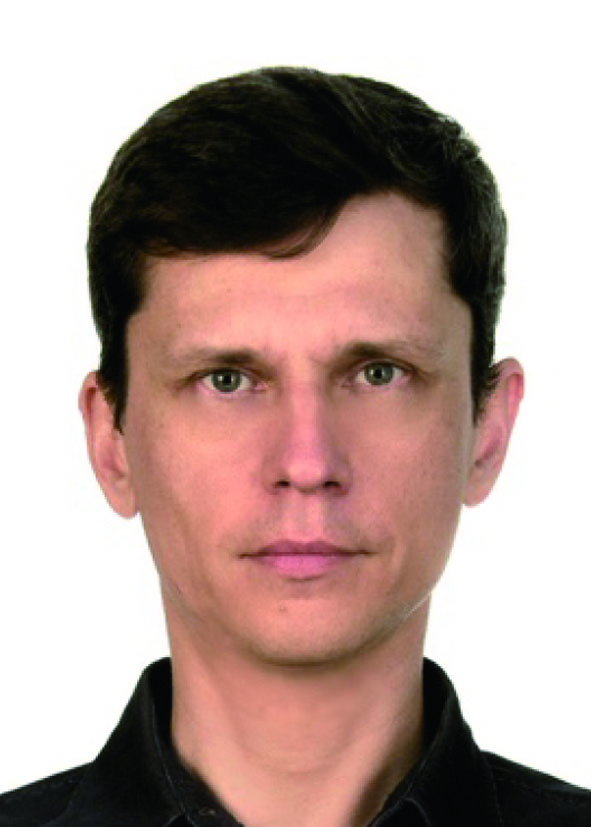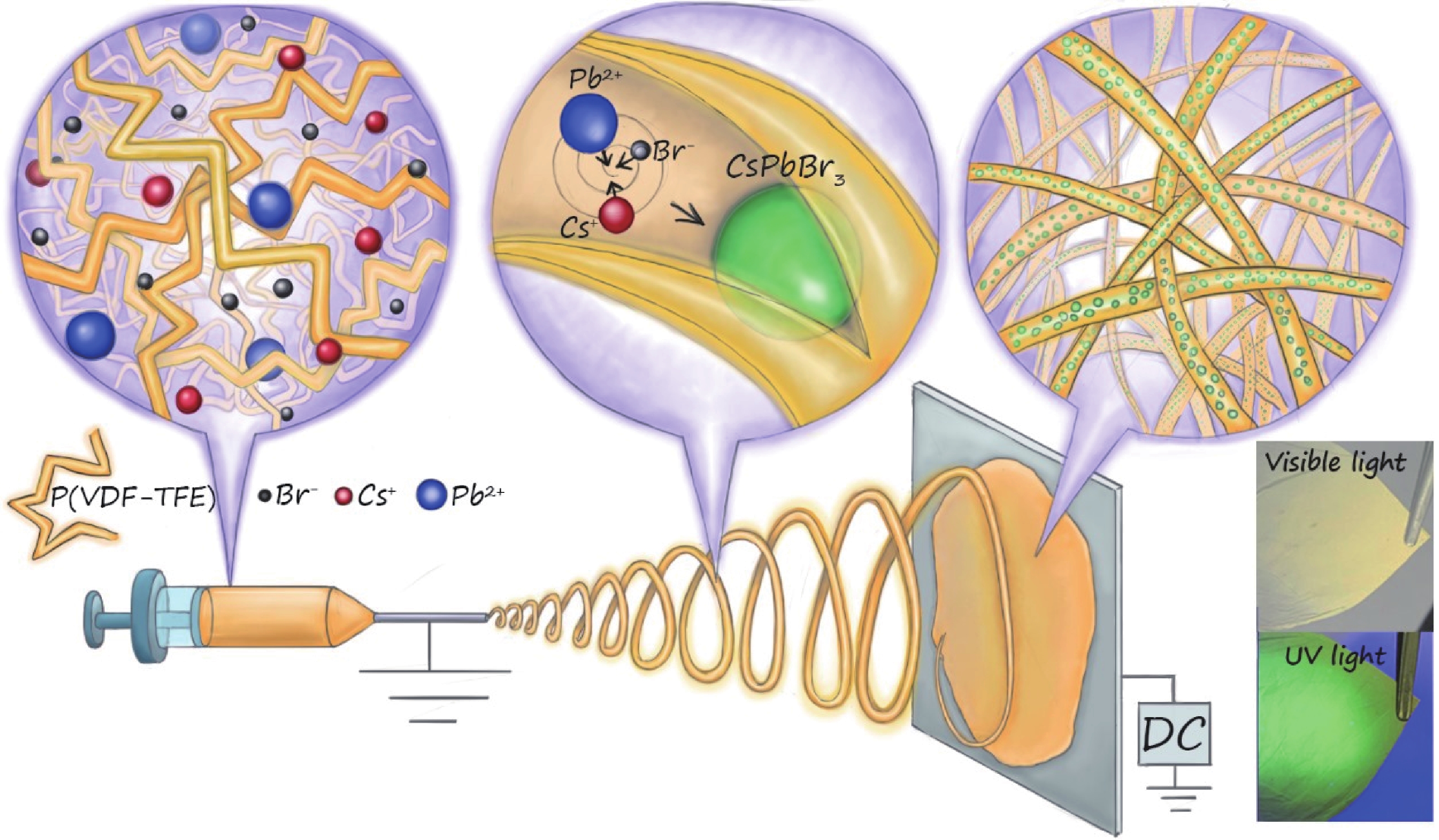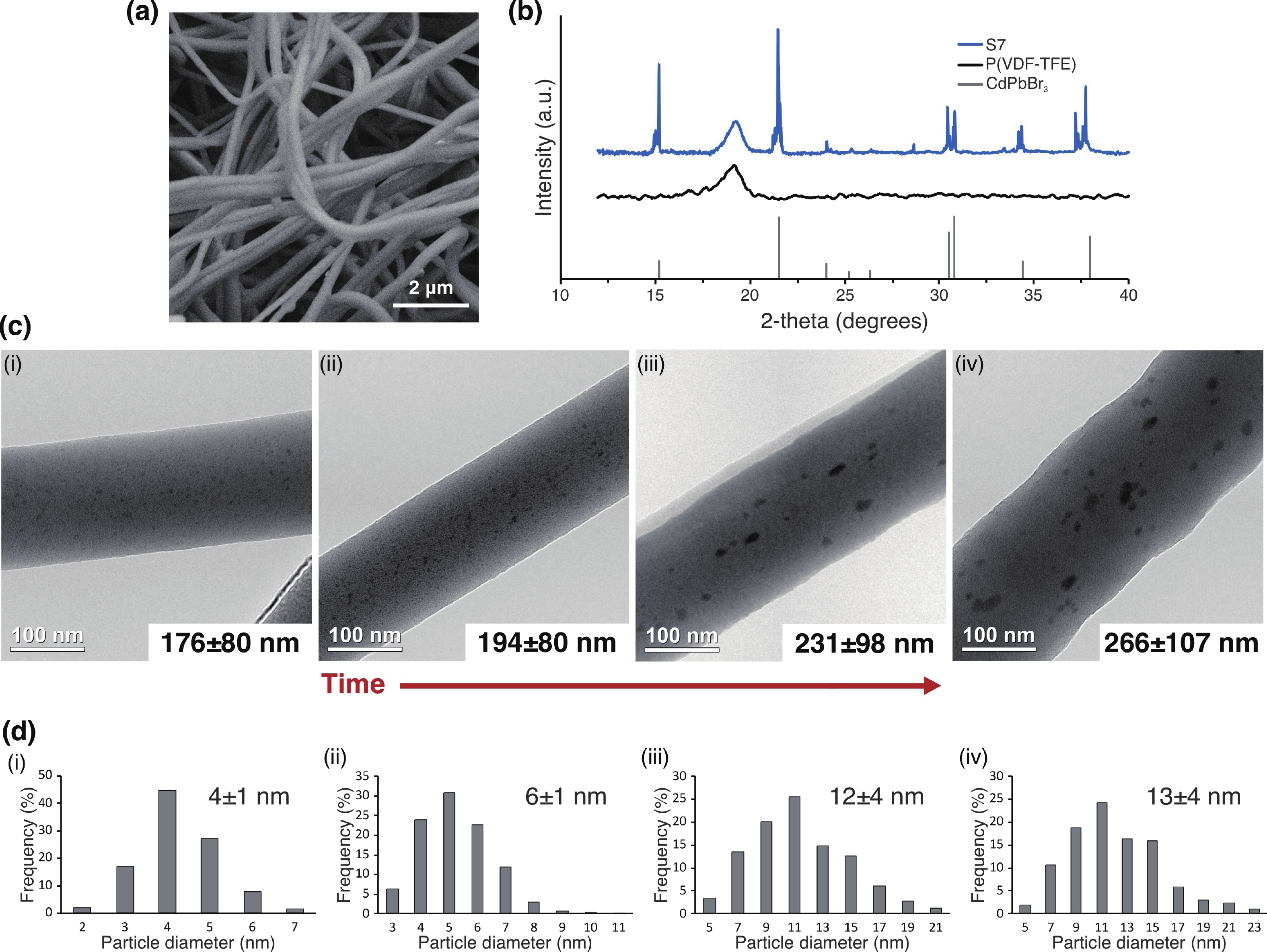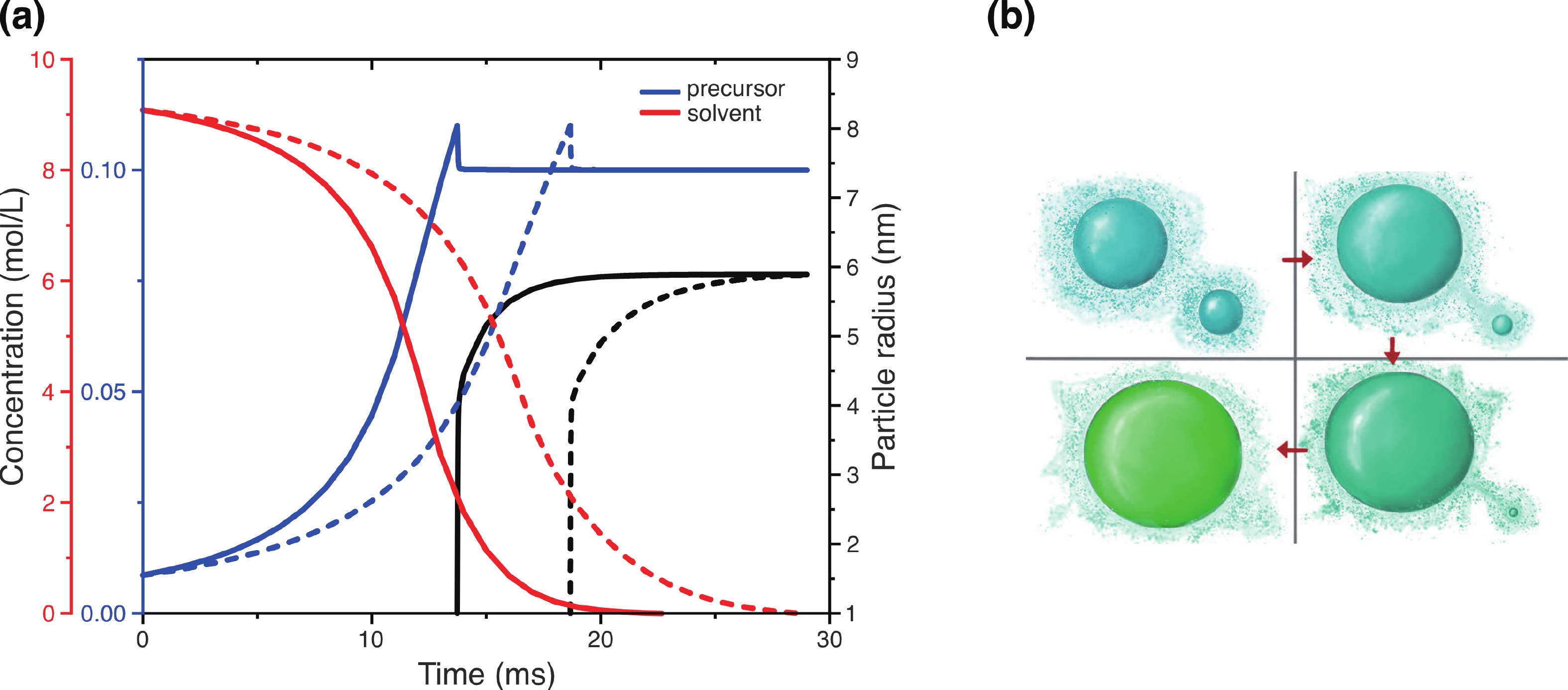| Citation: |
Alexey Serdobintsev, Vladimir Neplokh, Alexander Koryakin, Ilia Kozhevnikov, Anastasiya Yakubova, Demid Kirilenko, Mariia Saveleva, Sergey Makarov, Ivan Mukhin, Polina Demina. In situ synthesis and stabilization of perovskite quantum dots in electrospinned fibers[J]. Journal of Semiconductors, 2026, In Press. doi: 10.1088/1674-4926/25060014
****
A Serdobintsev, V Neplokh, A Koryakin, I Kozhevnikov, A Yakubova, D Kirilenko, M Saveleva, S Makarov, I Mukhin, and P Demina, In situ synthesis and stabilization of perovskite quantum dots in electrospinned fibers[J]. J. Semicond., 2026, 47(2), 022801 doi: 10.1088/1674-4926/25060014
|
In situ synthesis and stabilization of perovskite quantum dots in electrospinned fibers
DOI: 10.1088/1674-4926/25060014
CSTR: 32376.14.1674-4926.25060014
More Information-
Abstract
Flexible materials with perovskite quantum dots (PQDs) are widely used in the field of photonics and opto-electronics due to their unique properties. Development of new materials based on these nanoparticles, incorporated into flexible and lightweight nonwoven fabrics, demonstrated high photoconductivity and efficient light energy conversion. In this work, we propose a method for creating a stable luminescent nonwoven material using electrospinning, in which inorganic salt precursors are used without the need for additional stabilizers. Equimolar solutions of cesium and lead (Ⅱ) bromide were mixed with a fluoroplast, resulting in a series of samples. Luminescent materials were obtained containing PQDs with a composition of CsPbBr3, with emission peaks ranging from 507 to 517 nm under 365-nm excitation. We have experimentally established and theoretically confirmed that the peak position is related to the size of the particles formed in the fiber during electrospinning and depends on processing time. Developed materials exhibited stable luminescent properties for up to 2.5 years, making them a promising candidate for the development of new flexible optoelectronic devices based on PQDs.-
Keywords:
- perovskite,
- quantum dots,
- fluoroplast,
- electrospinning
-
References
[1] McKittrick J, Shea-Rohwer L E. Review: Down conversion materials for solid-state lighting. J Am Ceram Soc, 2014, 97(5), 1327 doi: 10.1111/jace.12943[2] Zhang Q G, Zheng W L, Wan Q, et al. Confined synthesis of stable and uniform CsPbBr3 nanocrystals with high quantum yield up to 90% by high temperature solid-state reaction. Adv Opt Mater, 2021, 9(11), 2002130 doi: 10.1002/adom.202002130[3] Aftabuzzaman M, Hong Y J, Jeong S, et al. Colloidal perovskite nanocrystals for blue-light-emitting diodes and displays. Adv Sci, 2025, 12(15), 2409736 doi: 10.1002/advs.202409736[4] Boussoufi F, Pousthomis M, Kuntzmann A, et al. Spray-drying polymer encapsulation of CsPbBr3 perovskite nanocrystals with enhanced photostability for LED downconverters. ACS Appl Nano Mater, 2021, 4(7), 7502 doi: 10.1021/acsanm.1c01552[5] Raja S N, Bekenstein Y, Koc M A, et al. Encapsulation of perovskite nanocrystals into macroscale polymer matrices: Enhanced stability and polarization. ACS Appl Mater Interfaces, 2016, 8(51), 35523 doi: 10.1021/acsami.6b09443[6] Xu J Y, Zhang Y C, Liu S, et al. Investigating perovskite nanocrystal stability though polymer encapsulation: A nano-array method. J Mater Chem C, 2025, 13(15), 7671 doi: 10.1039/D4TC05397D[7] Liu G Y, Li Z H, Lai Z, et al. Flexible, stretchable, and luminescent hydrogels based on a polydimethylsiloxane-coated CsPbBr3 nanostructure for elastomers. ACS Appl Nano Mater, 2023, 6(11), 9588 doi: 10.1021/acsanm.3c01283[8] Akbulatov A F, Luchkin S Y, Frolova L A, et al. Probing the intrinsic thermal and photochemical stability of hybrid and inorganic lead halide perovskites. J Phys Chem Lett, 2017, 8(6), 1211 doi: 10.1021/acs.jpclett.6b03026[9] Kulbak M, Gupta S, Kedem N, et al. Cesium enhances long-term stability of lead bromide perovskite-based solar cells. J Phys Chem Lett, 2016, 7(1), 167 doi: 10.1021/acs.jpclett.5b02597[10] Conings B, Drijkoningen J, Gauquelin N, et al. Intrinsic thermal instability of methylammonium lead trihalide perovskite. Adv Energy Mater, 2015, 5(15), 1500477 doi: 10.1002/aenm.201500477[11] Carpenella V, Messina F, Barichello J, et al. Physical and chemical properties and degradation of MAPbBr3 films on transparent substrates. Phys Chem Chem Phys, 2024, 26(27), 18898 doi: 10.1039/D4CP01509F[12] McGovern L, Futscher M H, Muscarella L A, et al. Understanding the stability of MAPbBr3 versus MAPbI3: Suppression of methylammonium migration and reduction of halide migration. J Phys Chem Lett, 2020, 11(17), 7127 doi: 10.1021/acs.jpclett.0c01822[13] Park B W, Seok S I. Intrinsic instability of inorganic-organic hybrid halide perovskite materials. Adv Mater, 2019, 31(20), e1805337 doi: 10.1002/adma.201805337[14] Ip A H, Kiani A, Kramer I J, et al. Infrared colloidal quantum dot photovoltaics via coupling enhancement and agglomeration suppression. ACS Nano, 2015, 9(9), 8833 doi: 10.1021/acsnano.5b02164[15] Protesescu L, Yakunin S, Bodnarchuk M I, et al. Nanocrystals of cesium lead halide perovskites (CsPbX3, X = Cl, Br, and I): Novel optoelectronic materials showing bright emission with wide color gamut. Nano Lett, 2015, 15(6), 3692 doi: 10.1021/nl5048779[16] Jiang G C, Erdem O, Hübner R, et al. Mechanosynthesis of polymer-stabilized lead bromide perovskites: Insight into the formation and phase conversion of nanoparticles. Nano Res, 2021, 14(4), 1078 doi: 10.1007/s12274-020-3152-7[17] Jeon M G, Kabir R M, Kim S, et al. Highly processable and stable PMMA-grafted CsPbBr3–SiO2 nanoparticles for down-conversion photoluminescence. Compos Part B Eng, 2022, 239, 109956 doi: 10.1016/j.compositesb.2022.109956[18] Wijayanti I D, Saputra A K, Ibrahim F, et al. An ultra-low-cost and adjustable in-house electrospinning machine to produce PVA nanofiber. HardwareX, 2022, 11, e00315 doi: 10.1016/j.ohx.2022.e00315[19] Hu X B, Xu Y Q, Wang J C, et al. In situ fabrication of superfine perovskite composite nanofibers with ultrahigh stability by one-step electrospinning toward white light-emitting diode. Adv Fiber Mater, 2023, 5(1), 183 doi: 10.1007/s42765-022-00207-x[20] Zhang Y F, Pan Y W, Ni J, et al. In situ growth of CsPbBr3@PS flexible fiber papers by one step electrospinning with high stability toward fluorescent sensor. J Lumin, 2023, 259, 119832 doi: 10.1016/j.jlumin.2023.119832[21] Kianfar P, Bongiovanni R, Ameduri B, et al. Electrospinning of fluorinated polymers: Current state of the art on processes and applications. Polym Rev, 2023, 63(1), 127 doi: 10.1080/15583724.2022.2067868[22] Améduri B. The promising future of fluoropolymers. Macro Chemistry & Physics, 2020, 221(8), 1900573[23] Aronov A M, Bol’basov E N, Guzeev V V, et al. Biological composites based on fluoropolymers with hydroxyapatite for intramedullary implants. Biomed Eng, 2010, 44(3), 108 doi: 10.1007/s10527-010-9166-9[24] Babu K J, Kaur G, Shukla A, et al. In situ CsPbBr3 architecture engineered in electrospun fibers and its ultrafast charge-transfer dynamics. Mater Adv, 2022, 3(16), 6566 doi: 10.1039/D2MA00503D[25] Ahmad Bkkar M, Olekhnovich R O, Kremleva A V, et al. Fabrication of electrospun polymer nanofibers modified with all-inorganic perovskite nanocrystals for flexible optoelectronic devices. Appl Nanosci, 2022, 12(10), 2961 doi: 10.1007/s13204-022-02603-6[26] Li W, Wang T T, Zheng C, et al. Composition-dependent optical limiting behavior of all-inorganic halide perovskite quantum dots. Opt Mater, 2020, 110, 110521 doi: 10.1016/j.optmat.2020.110521[27] Neplokh V, Markina D I, Baeva M, et al. Recrystallization of CsPbBr3 nanoparticles in fluoropolymer nonwoven mats for down- and up-conversion of light. Nanomaterials, 2021, 11(2), 412 doi: 10.3390/nano11020412[28] Zhang X, Wang F. Recent advances in flexible alternating current electroluminescentdevices. APL Mater, 2021, 9(3), 030701 doi: 10.1063/5.0040109[29] Liu X H, Yu D J, Huo C X, et al. A perovskite light-emitting device driven by low-frequency alternating current voltage. Adv Opt Mater, 2018, 6(16), 1800206 doi: 10.1002/adom.201800206[30] Kondawar S B, Haque M A, Pangul C N. Application of electrospun materials in LEDs. Polymers for light‐emitting devices and displays. Hoboken: Scrivener Publishing LLC, 2020[31] Ramade J, Andriambariarijaona L M, Steinmetz V, et al. Fine structure of excitons and electron-hole exchange energy in polymorphic CsPbBr3 single nanocrystals. Nanoscale, 2018, 10(14), 6393 doi: 10.1039/C7NR09334A[32] Curtis Beimborn J 2nd, Walther L R, Wilson K D, et al. Size-dependent pressure-response of the photoluminescence of CsPbBr3 nanocrystals. J Phys Chem Lett, 2020, 11(5), 1975 doi: 10.1021/acs.jpclett.0c00174[33] Cheng O H, Qiao T, Sheldon M, et al. Size- and temperature-dependent photoluminescence spectra of strongly confined CsPbBr3 quantum dots. Nanoscale, 2020, 12(24), 13113 doi: 10.1039/D0NR02711A[34] Ferreira D L, Silva A G, Schiavon M A, et al. Determination of the particle size distribution of cube-shaped colloidal perovskite quantum dots from photoluminescence spectra: A combined theoretical-experimental approach. J Chem Phys, 2024, 161(16), 164109 doi: 10.1063/5.0234432[35] Lu Z D, Li Y X, Qiu W T, et al. Composite films of CsPbBr3 perovskite nanocrystals in a hydrophobic fluoropolymer for temperature imaging in digital microfluidics. ACS Appl Mater Interfaces, 2020, 12(17), 19805 doi: 10.1021/acsami.0c02128[36] Tian T, Yang M F, Fang Y X, et al. Large-area waterproof and durable perovskite luminescent textiles. Nat Commun, 2023, 14(1), 234 doi: 10.1038/s41467-023-35830-8[37] Baeva M, Miroshnichenko A S, Kenesbay R, et al. Enhancing the CsPbBr3 PeLEC properties via PDMS/PMHS double-layer polymer encapsulation and high relative humidity stress-aging. J Mater Chem C, 2023, 11(43), 15261 doi: 10.1039/D3TC01370G[38] Drobny J G, Ebnesajjad S. Technology of fluoropolymers: A Concise Handbook. Boca Raton: CRC Press, 2023[39] Zaarour B, Zhu L, Huang C, et al. Controlling the secondary surface morphology of electrospun PVDF nanofibers by regulating the solvent and relative humidity. Nanoscale Res Lett, 2018, 13(1), 285 doi: 10.1186/s11671-018-2705-0[40] Zaarour B, Zhu L, Huang C, et al. Enhanced piezoelectric properties of randomly oriented and aligned electrospun PVDF fibers by regulating the surface morphology. J Appl Polym Sci, 2019, 136(6), 47049 doi: 10.1002/app.47049[41] Wu X F, Salkovskiy Y, Dzenis Y A. Modeling of solvent evaporation from polymer jets in electrospinning. Appl Phys Lett, 2011, 98(22), 223108 doi: 10.1063/1.3585148[42] Sano Y, Yamamoto S, Yamamoto H, et al. Drying of a drop of polymer solution of PAN (polyacrylonitrile)-DMF (dimethylformamide) system. J Chem Eng Japan, 1984, 17(2), 114 doi: 10.1252/jcej.17.114[43] Lugg G A. Diffusion coefficients of some organic and other vapors in air. Anal Chem, 1968, 40(7), 1072 doi: 10.1021/ac60263a006[44] National Library of Medicine. National Center for Biotechnology Information.[45] Wang Y, Wang C. Extension rate and bending behavior of electrospinning jet: The role of solution conductivity. Polymer, 2021, 222, 123672 doi: 10.1016/j.polymer.2021.123672[46] Maghsoodlou S, Noroozi B, Haghi A K. A simple model for solvent evaporation in electrospinning process. Nano, 2017, 12(3), 1750028 doi: 10.1142/S179329201750028X[47] Dirin D N, Cherniukh I, Yakunin S, et al. Solution-grown CsPbBr3 perovskite single crystals for photon detection. Chem Mater, 2016, 28(23), 8470 doi: 10.1021/acs.chemmater.6b04298[48] Markov I V. Crystal Growth for Beginners. 2nd Ed. Singapore: World Scientific, 2003[49] Dubrovskii V G. Nucleation theory and growth of nanostructures. Berlin, Heidelberg: Springer Berlin Heidelberg, 2014[50] Shutov A A, Astakhov E Y. Formation of fibrous filtering membranes by electrospinning. Tech Phys, 2006, 51(8), 1093 doi: 10.1134/S1063784206080214[51] McKee M G, Wilkes G L, Colby R H, et al. Correlations of solution rheology with electrospun fiber formation of linear and branched polyesters. Macromolecules, 2004, 37(5), 1760 doi: 10.1021/ma035689h[52] Holyst R, Bielejewska A, Szymański J, et al. Scaling form of viscosity at all length-scales in poly(ethylene glycol) solutions studied by fluorescence correlation spectroscopy and capillary electrophoresis. Phys Chem Chem Phys, 2009, 11(40), 9025 doi: 10.1039/b908386c[53] Filip P, Zelenkova J, Peer P. Electrospinning of a copolymer PVDF-co-HFP solved in DMF/acetone: Explicit relations among viscosity, polymer concentration, DMF/acetone ratio and mean nanofiber diameter. Polymers, 2021, 13(19), 3418 doi: 10.3390/polym13193418 -
Supplements
 25060014Supporting_Information.pdf
25060014Supporting_Information.pdf

-
Proportional views





 Alexey Serdobintsev got his BS degree in 2001, MS degree in 2003 and PhD degree in 2006 at Saratov State University. Now he is associated professor and head of the laboratory at Saratov State University. His research interests include flexible electronics, thin film deposition and electrospinning.
Alexey Serdobintsev got his BS degree in 2001, MS degree in 2003 and PhD degree in 2006 at Saratov State University. Now he is associated professor and head of the laboratory at Saratov State University. His research interests include flexible electronics, thin film deposition and electrospinning.
 DownLoad:
DownLoad:



















